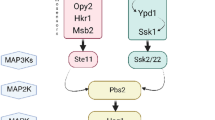Abstract
The mechanism of yeast cell death induced by heat shock was found to be dependent on the intensity of heat exposure. Moderate (45°C) heat shock strongly increased the generation of reactive oxygen species (ROS) and cell death. Pretreatment with cycloheximide (at 30°C) suppressed cell death, but produced no effect on ROS production. The protective effect was absent if cycloheximide was added immediately before heat exposure and the cells were incubated with the drug during the heat treatment and recovery period. The rate of ROS production and protective effect of cycloheximide on viability were significantly decreased in the case of severe (50°C) heat shock. Treatment with cycloheximide at 39°C inhibited the induction of Hsp104 synthesis and suppressed the development of induced thermotolerance to severe shock (50°C), but it had no effect on induced thermotolerance to moderate (45°C) heat shock. At the same time, Hsp104 effectively protected cells from death independently of the intensity of heat exposure. These data indicate that moderate heat shock induced programmed cell death in the yeast cells, and cycloheximide suppressed this process by inhibiting general synthesis of proteins.
Similar content being viewed by others
Abbreviations
- CFU:
-
colony-forming units
- DCF:
-
2′,7′-dichlo-rofluorescein
- Dnm1:
-
dynamin 1
- H2DCF·DA:
-
2′,7′-dichlorodihydrofluorescein diacetate
- Hsps:
-
heat shock proteins
- PCD:
-
programmed cell death
- ROS:
-
reactive oxygen species
- SDS:
-
sodium dodecyl sulfate
- Yca1 (MCA1):
-
yeast caspase 1
References
Alexandrov, V. J., and Kislyuk, I. M. (1994) Tsitologiya, 36, 5–59.
Verghese, J., Abrams, J., Wang, Y., and Morano, K. A. (2012) Microbiol. Mol. Biol. Rev., 76, 115–158.
McAlister, L., and Finkelstein, D. B. (1980) Biochem. Biophys. Res. Commun., 93, 819–824.
Craig, E. A., and Jacobsen, K. (1984) Cell, 38, 841–849.
Piper, P. W. (1993) FEMS Microbiol. Rev., 11, 339–355.
Hall, B. G. (1983) J. Bacteriol., 156, 1363–1365.
Watson, K., Dunlop, G., and Cavicchioli, R. (1984) FEBS Lett., 172, 299–302.
Rikhvanov, E. G., Varakina, N. N., Rusaleva, T. M., Rachenko, E. I., Knorre, D. A., and Voinikov, V. K. (2005) Curr. Genet., 48, 44–59.
Rikhvanov, E. G., Romanova, N. V., and Chernoff, Y. O. (2007) Prion, 4, 217–222.
Samali, A., Holmberg, C. I., Sistonen, L., and Orrenius, S. (1999) FEBS Lett., 461, 306–310.
Sukhanova, E. I., Rogov, A. G., Severin, F. F., and Zvyagilskaya, R. A. (2012) Biochemistry (Moscow), 77, 761–775.
Chen, S. R., Dunigan, D. D., and Dickman, M. B. (2003) Free Radic. Biol. Med., 34, 1315–1325.
Fahrenkrog, B., Sauder, U., and Aebi, U. (2004) J. Cell Sci., 117, 115–126.
Teng, X., Cheng, W. C., Qi, B., Yu, T. X., Ramachandran, K., Boersma, M. D., Hattier, T., Lehmann, P. V., Pineda, F. J., and Hardwick, J. M. (2011) Cell Death Dis., 4, e188.
Cebulski, J., Malouin, J., Pinches, N., Cascio, V., and Austriaco, N. (2011) PLoS One, 6, e20882.
Madeo, F., Frohlich, E., Ligr, M., Grey, M., Sigrist, S. J., Wolf, D. H., and Frohlich, K. U. (1999) J. Cell Biol., 145, 757–767.
Ludovico, P., Sousa, M. J., Silva, M. T., Leao, C., and Corte-Real, M. (2001) Microbiology, 147, 2409–2415.
Severin, F. F., and Hyman, A. A. (2002) Curr. Biol., 12, 233–235.
Lowry, O. H., Rosebrough, N. J., Farr, A. L., and Randall, R. J. (1951) J. Biol. Chem., 193, 265–275.
Timmons, T. M., and Dunbar, B. S. (1990) Methods Enzymol., 182, 679–701.
Fedoseeva, I. V., Pjatricas, D. V., Varakina, N. N., Rusaleva, T. M., Stepanov, A. V., Rikhvanov, E. G., Borovskii, G. B., and Voinikov, V. K. (2012) Biochemistry (Moscow), 77, 78–86.
Mosser, D. D., Ho, S., and Glover, J. R. (2004) Biochemistry, 43, 8107–8715.
Lee, R. E., Brunette, S., Puente, L. G., and Megeney, L. A. (2010) Proc. Natl. Acad. Sci. USA, 107, 13348–13353.
Tessarz, P., Schwarz, M., Mogk, A., and Bukau, B. (2009) Mol. Cell. Biol., 29, 3738–3745.
Flower, T. R., Chesnokova, L. S., Froelich, C. A., Dixon, C., and Witt, S. N. (2005) J. Mol. Biol., 351, 1081–1100.
Magherini, F., Tani, C., Gamberi, T., Caselli, A., Bianchi, L., Bini, L., and Modesti, A. (2007) Proteomics, 7, 1434–1445.
Gasch, A. P., Spellman, P. T., Kao, C. M., Carmel-Harel, O., Eisen, M. B., Storz, G., Botstein, D., and Brown, P. O. (2000) Mol. Biol. Cell, 11, 4241–4257.
Rikhvanov, E. G., Varakina, N. N., Rusaleva, T. M., Rachenko, E. I., and Voinikov, V. K. (2003) Microbiology, 72, 423–428.
Zakrzewska, A., van Eikenhorst, G., Burggraaff, J. E., Vis, D. J., Hoefsloot, H., Delneri, D., Oliver, S. G., Brul, S., and Smits, G. J. (2011) Mol. Biol. Cell, 22, 4435–4446.
Sokolov, S., Pozniakovsky, A., Bocharova, N., Knorre, D., and Severin, F. (2006) Biochim. Biophys. Acta, 1757, 660–666.
Author information
Authors and Affiliations
Corresponding author
Additional information
Published in Russian in Biokhimiya, 2014, Vol. 79, No. 1, pp. 22–32.
Originally published in Biochemistry (Moscow) On-Line Papers in Press, as Manuscript BM13-232, November 24, 2013.
Rights and permissions
About this article
Cite this article
Rikhvanov, E.G., Fedoseeva, I.V., Varakina, N.N. et al. Mechanism of Saccharomyces cerevisiae yeast cell death induced by heat shock. Effect of cycloheximide on thermotolerance. Biochemistry Moscow 79, 16–24 (2014). https://doi.org/10.1134/S0006297914010039
Received:
Revised:
Published:
Issue Date:
DOI: https://doi.org/10.1134/S0006297914010039




